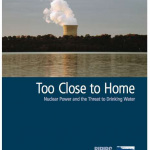Too Close to Home
Nuclear Power and the Threat to Drinking Water
The 2011 Fukushima Daiichi nuclear disaster delivered a reminder to the world that nuclear power comes with inherent risks. Among the risks demonstrated by the Fukushima crisis is the threat of water contamination, including contamination of drinking water supplies by radioactive material. In the United States, 49 million Americans receive their drinking water from surface sources located within 50 miles of an active nuclear power plant—inside the boundary the Nuclear Regulatory Commission uses to assess risk to food and water supplies.
Downloads
Environment Rhode Island Research & Policy Center, RIPIRG Education Fund

The Fukushima Daiichi nuclear disaster, which took place in March 2011, delivered a reminder to the world that nuclear power comes with inherent risks. Over a period of several days, three Japanese nuclear reactors suffered meltdowns. A large amount of radioactive material escaped into the environment over the ensuing months.
Among the risks demonstrated by the Fukushima crisis is the threat of water contamination—including contamination of drinking water supplies by radioactive material. In the wake of the Fukushima accident, drinking water sources as far as 130 miles from the plant were contaminated with radioactive iodine, prompting cities such as Tokyo to warn against consumption of the water by infants.
In the United States, 49 million Americans receive their drinking water from surface sources located within 50 miles of an active nuclear power plant—inside the boundary the Nuclear Regulatory Commission uses to assess risk to food and water supplies.
Airborne contamination in the wake of a nuclear accident is not the only threat nuclear power poses to water supplies. Leakage of radioactive material into groundwater is a common occurrence at U.S. nuclear power plants, even if the amount of radioactivity released is tiny compared to that released at Fukushima. In addition, U.S. nuclear power plants draw their cooling water supplies from critical waterways nationwide—making those water supplies the natural destination for spilled or dumped radioactive liquid, and putting them at risk of contamination in a Fukushima-type accident.
The inherent risks posed by nuclear power suggest that the United States should move to a future without nuclear power.
The nation should:
- Retire existing nuclear power plants, at the latest, at the end of their current operating licenses.
- Abandon plans for new nuclear power plants.
- Adopt policies to expand energy efficiency and production of energy from clean, renewable sources such as wind and solar power.
In the meantime, the United States should reduce the risks nuclear power poses to water supplies by:
- Completing a thorough safety review of U.S. nuclear power plants and re- quiring plant operators to implement recommended changes immediately.
- Ensuring that emergency plans account for the potential impacts of drinking water contamination to residents outside the current 50-mile boundary used in planning.
- Requiring nuclear plant operators to implement regular groundwater tests in order to catch tritium leaks.
- Enforcing laws against tritium leaks by fining plant operators for unauthorized releases of radioactive materials.
- Require that nuclear waste be stored as safely as possible, preferably by using hardened dry cask storage (which reduces the risk associated with spent fuel pools).
- Requiring plants to take steps—such as construction of on-site storage capacity for contaminated water—to prevent the release of radioactive water in the event of an accident. Plant operators should have a plan to contain the amount of water that they anticipate using to flood the reactor in a worst-case scenario.
